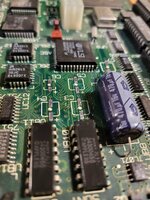A functional Mac SE (FDHD) was passed along to me, and this has set me along the path of a restoration project that I’ve had in mind to try for some time.
I’ve replaced a few faulty RAM modules to get it properly working again, and I’ve also disassembled and cleaned the Floppy Drive and replaced a broken eject gear. The battery had not leaked, but it has been removed for the time being.
I had the very good fortune to purchase a Raspberry Pi and set up RaSCSI -- eventually, that will all be mounted inside the case.
Current plans call for disassembly, cleaning and retrobrighting the case (I’ve had success with this before with other projects), and I’ve been thinking, at that time, I might also replace the capacitors. My understanding is that the Mac SE is much less prone to damage from leaking capacitors -- but still, they’re what -- 30 years old at this point? My soldering skills are basic, at best, but I’m good at following explicit instructions, and this seems like a task I should be able to handle.
Initially, my thinking was I’d try to do everything all at once -- replace all the caps while the Mac has been disassembled for cleaning -- but I don’t want to get myself in for more than I’m prepared (or have the spare time for).
I’ve been wondering -- how might I prioritize this project, in terms of what maintenance is likely to be more important in the short term? Should I work on the Analog Board first, as removing that is much more complicated? Or are the components on the Logic Board more prone to failure?
I’m interested in advice and guidance from others who have been down this path!
I’ve replaced a few faulty RAM modules to get it properly working again, and I’ve also disassembled and cleaned the Floppy Drive and replaced a broken eject gear. The battery had not leaked, but it has been removed for the time being.
I had the very good fortune to purchase a Raspberry Pi and set up RaSCSI -- eventually, that will all be mounted inside the case.
Current plans call for disassembly, cleaning and retrobrighting the case (I’ve had success with this before with other projects), and I’ve been thinking, at that time, I might also replace the capacitors. My understanding is that the Mac SE is much less prone to damage from leaking capacitors -- but still, they’re what -- 30 years old at this point? My soldering skills are basic, at best, but I’m good at following explicit instructions, and this seems like a task I should be able to handle.
Initially, my thinking was I’d try to do everything all at once -- replace all the caps while the Mac has been disassembled for cleaning -- but I don’t want to get myself in for more than I’m prepared (or have the spare time for).
I’ve been wondering -- how might I prioritize this project, in terms of what maintenance is likely to be more important in the short term? Should I work on the Analog Board first, as removing that is much more complicated? Or are the components on the Logic Board more prone to failure?
I’m interested in advice and guidance from others who have been down this path!

